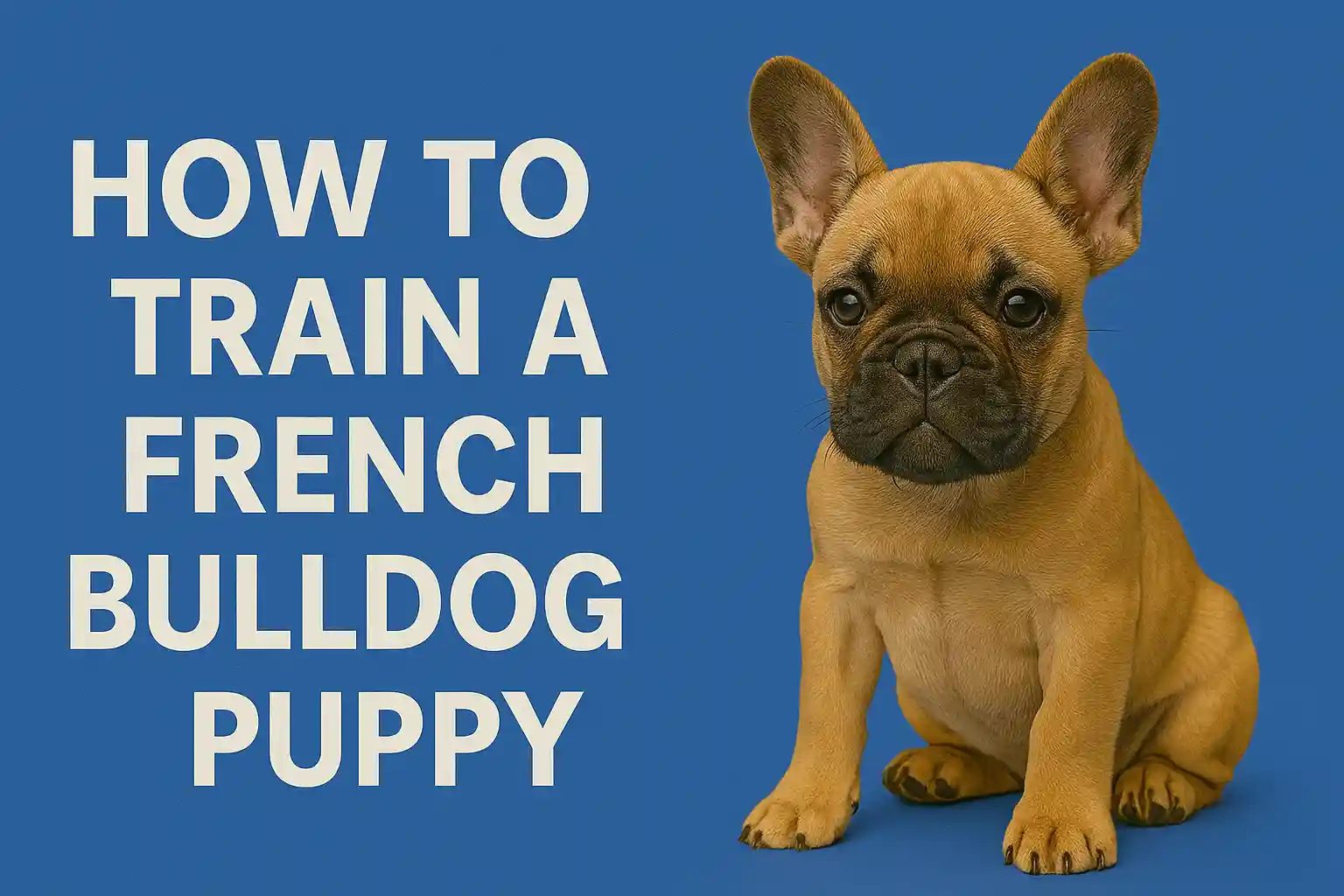Learning how to train a French Bulldog puppy requires patience, consistency, and understanding their unique personality traits. As a Frenchie owner for over 12 years, I’ve discovered the training approaches that actually work for these adorable but sometimes stubborn little companions.
When I brought home my first French Bulldog puppy, Milo, I made every training mistake in the book. His cute face made it nearly impossible to stay firm, and his stubborn personality left me wondering if training was even possible. But after years of experience (and a few chewed shoes later), I’ve developed effective techniques on how to train a French Bulldog puppy that work specifically for these compact bundles of personality. For a broader overview, check out our complete French Bulldog training guide.
Essential Training Techniques for French Bulldog Puppies
Mastering how to train a French Bulldog puppy starts with understanding their unique personality. French Bulldogs are known for their playful, affectionate nature, but also for their independent streak. This unique combination requires training techniques that respect their intelligence while working with their sometimes stubborn temperament.
Positive Reinforcement Methods
When figuring out how to train a French Bulldog puppy effectively, positive reinforcement is the most successful approach. My journey with Frenchie training took a dramatic turn when I switched to positive reinforcement. These dogs respond incredibly well to praise, treats, and affection rather than punishment or harsh corrections.
“The first time I tried positive reinforcement with my Frenchie, Hugo, it was like a lightbulb moment,” I remember thinking. “This dog who wouldn’t sit for anything suddenly became eager to learn when chicken treats entered the equation.”
For best results:
- Use high-value treats (small pieces of boiled chicken or cheese work wonders)
- Keep training sessions short (5-10 minutes maximum)
- Be enthusiastic with your praise
- Remain consistent with commands and rewards
- Train before meals when they’re more motivated by food
French Bulldogs especially respond to an excited, happy tone of voice. When Milo finally mastered “stay” after a week of training, my over-the-top celebration reinforced the behavior better than any treat could have.
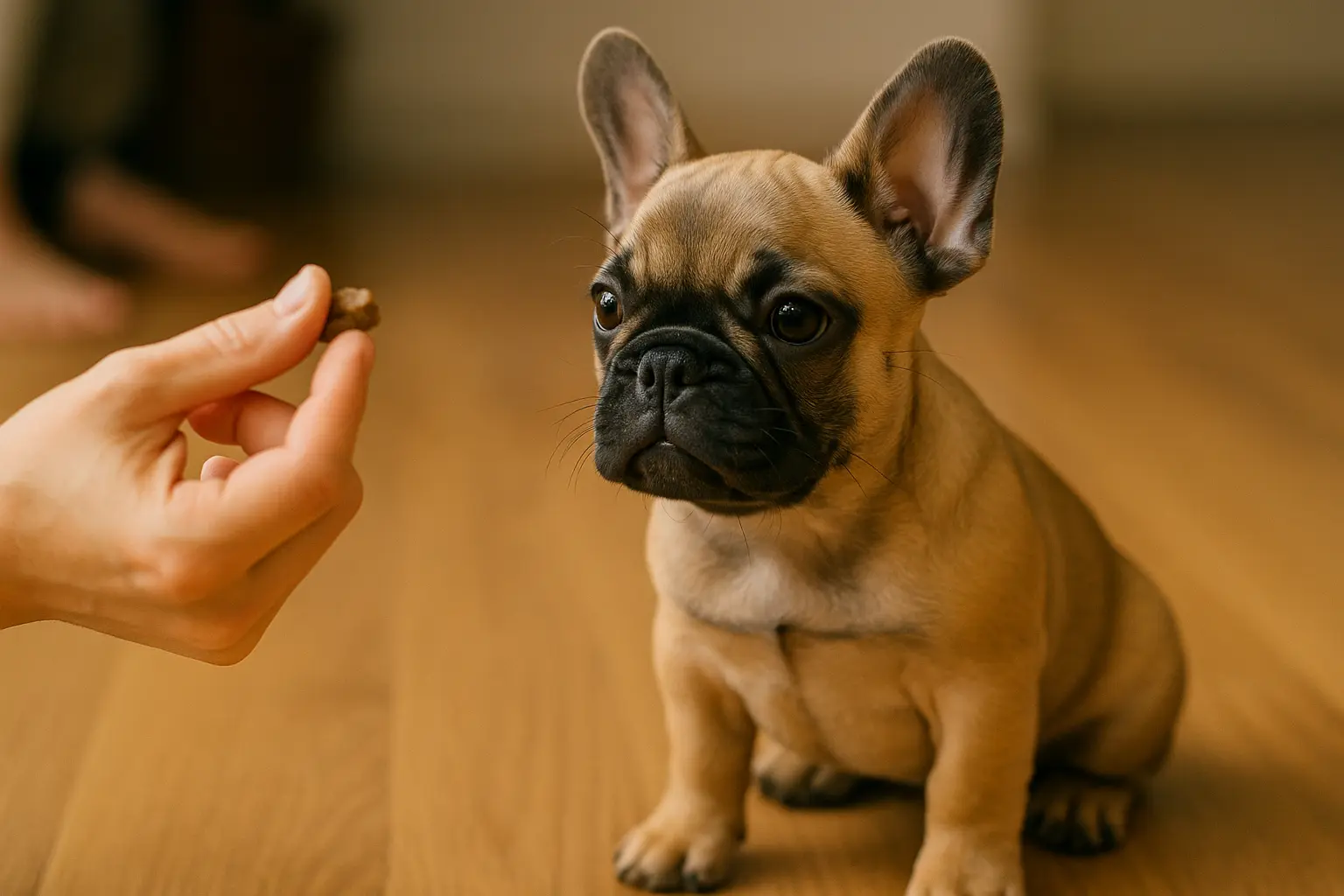
Clicker Training for French Bulldog Puppies
Clicker training is an excellent technique when learning how to toilet train a french bulldog puppy with precision. This method provides precise timing that works exceptionally well with the Frenchie attention span. When I introduced my Frenchie, Luna, to clicker training, her progress accelerated dramatically.
Here’s a simple way to start:
- Associate the click sound with rewards by clicking then immediately giving a treat (repeat 10-15 times)
- Begin asking for a simple behavior like sitting
- The moment your Frenchie sits, click and treat
- Repeat until they understand the click means “you did something right”
The beauty of clicker training is its clarity. When Luna would get distracted (as Frenchies often do), the distinctive click sound would immediately refocus her attention on the training task.
Crate Training Steps for French Bulldog Puppies
Crate training is an important part of how to toilet train a french bulldog puppy properly. It was a game-changer with my Frenchie puppies, providing them security while helping with house training. However, I learned the hard way that rushing this process leads to anxiety and barking.
Follow these steps for successful crate training:
- Introduce the crate gradually by placing treats and toys inside
- Feed meals near the crate, then eventually inside with the door open
- Begin closing the door for short periods while you remain nearby
- Gradually increase time in the crate with the door closed
- Start leaving the room for brief periods, then returning before any anxiety sets in
- Extend absences slowly as your puppy becomes comfortable
Remember that Frenchies are companion dogs who crave human interaction. When I first crate trained Milo, I made the mistake of leaving him too long, too soon. Start with just minutes, not hours.
Remember that when learning how to train a French Bulldog puppy to use a crate, never use the crate as punishment. When my second Frenchie, Bella, had an accident in the house, putting her in the crate as a “time out” was counterproductive. The crate should always be their safe, happy space.
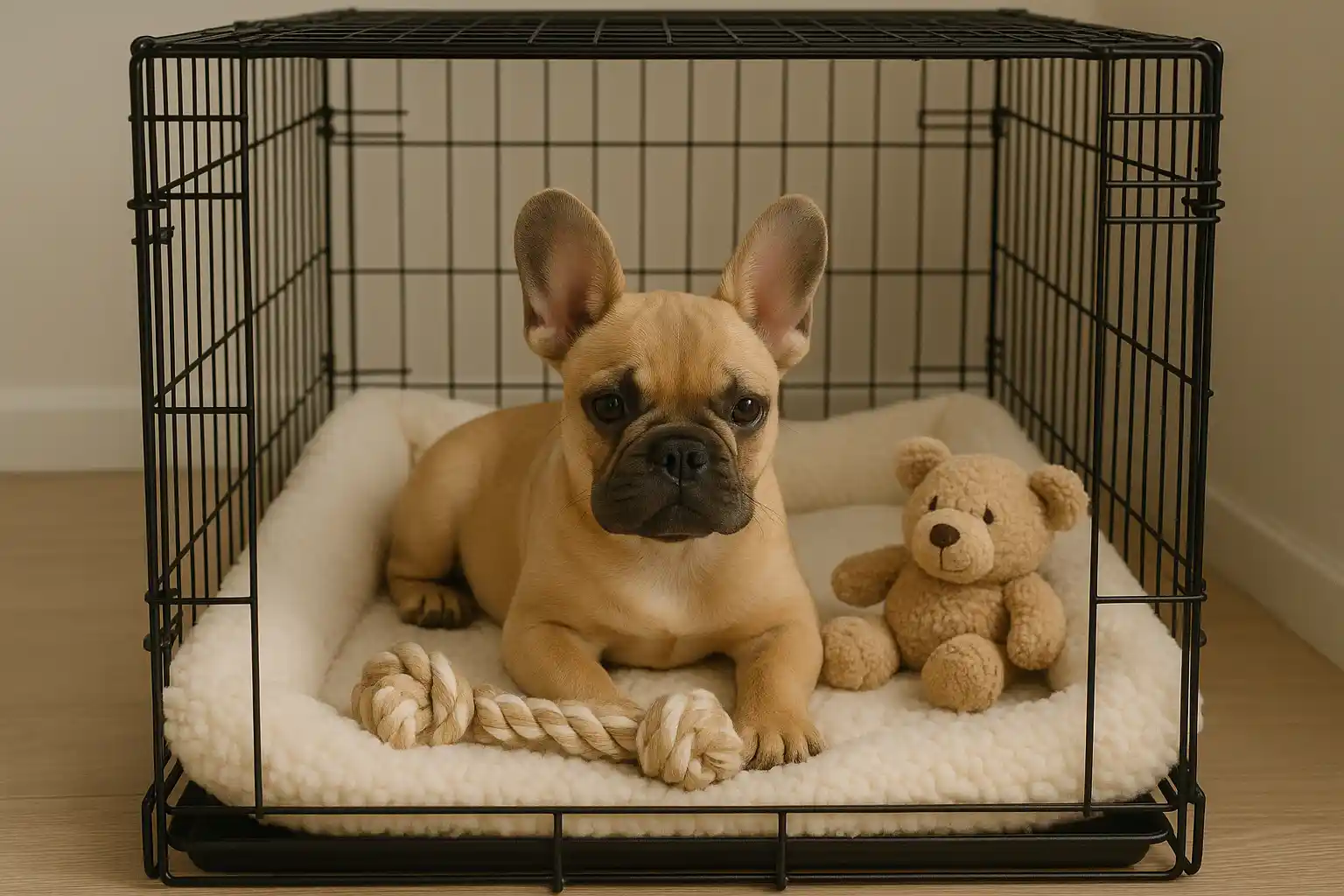
Basic Commands Every French Bulldog Should Learn
French Bulldogs thrive when they understand what’s expected of them. Teaching basic commands provides structure that helps them feel secure while making your life together much easier.
Teaching Sit and Stay to Your French Bulldog Puppy
The “sit” command is usually the easiest when learning how to toilet train a french bulldog puppy and serves as a foundation for more complex training. Let me share how I successfully taught this command to my Frenchies.
To teach “sit”:
- Hold a treat close to your puppy’s nose
- Move the treat upward and slightly over their head
- As their head follows the treat, their bottom will naturally lower
- The moment they sit, say “sit,” click (if using a clicker), and reward
- Practice 5-10 times per session, multiple times daily
For “stay”:
- Ask your puppy to sit
- Open your palm facing them and say “stay”
- Step back one step
- If they remain sitting, immediately return, praise, and treat
- If they move, start again but make it easier
- Gradually increase the distance and duration
With my Frenchie Hugo, I found that making eye contact during the “stay” command dramatically improved his focus. The connection between us became part of the training itself.
How to Train Your French Bulldog to Come When Called
Recall is arguably the most important command when learning how to train a French Bulldog puppy. I’ve found Frenchies can be particularly selective about when they choose to listen. The key is making “come” the most rewarding command in their vocabulary.
To teach reliable recall:
- Start in a distraction-free environment
- Say your puppy’s name followed by “come” in an excited voice
- When they move toward you, provide enthusiastic praise
- When they reach you, reward with their absolute favorite treat
- Practice regularly, gradually adding distance and distractions
Never call your Frenchie to you for anything negative (medication, crate time when you’re leaving, etc.). When Hugo needed eye drops, I would never use his recall command, as it would have damaged the positive association.
The “come” command saved my Frenchie Bella when she slipped out the front door. Because we had practiced extensively, she turned and ran back to me despite the exciting distractions outside.
Leash Training Techniques for French Bulldog Puppies
Understanding how to potty train a French Bulldog Puppy to walk properly on a leash is essential for enjoyable walks. Many French Bulldogs naturally pull on leash despite their small size. Their enthusiastic personality and strong chest muscles can make walks challenging without proper training.
I learned with Milo that starting leash training indoors removes initial distractions:
- Let your puppy wear their collar/harness around the house for short periods
- Attach the leash and let them drag it briefly while supervised
- Pick up the leash and encourage them to walk beside you with treats
- When outside, stop moving whenever they pull
- Only continue walking when there’s slack in the leash
- Reward frequently for walking nicely beside you
For Frenchies especially, I recommend a harness rather than a collar for leash training. Their respiratory anatomy (brachycephalic airway) makes collars potentially dangerous if they pull hard.
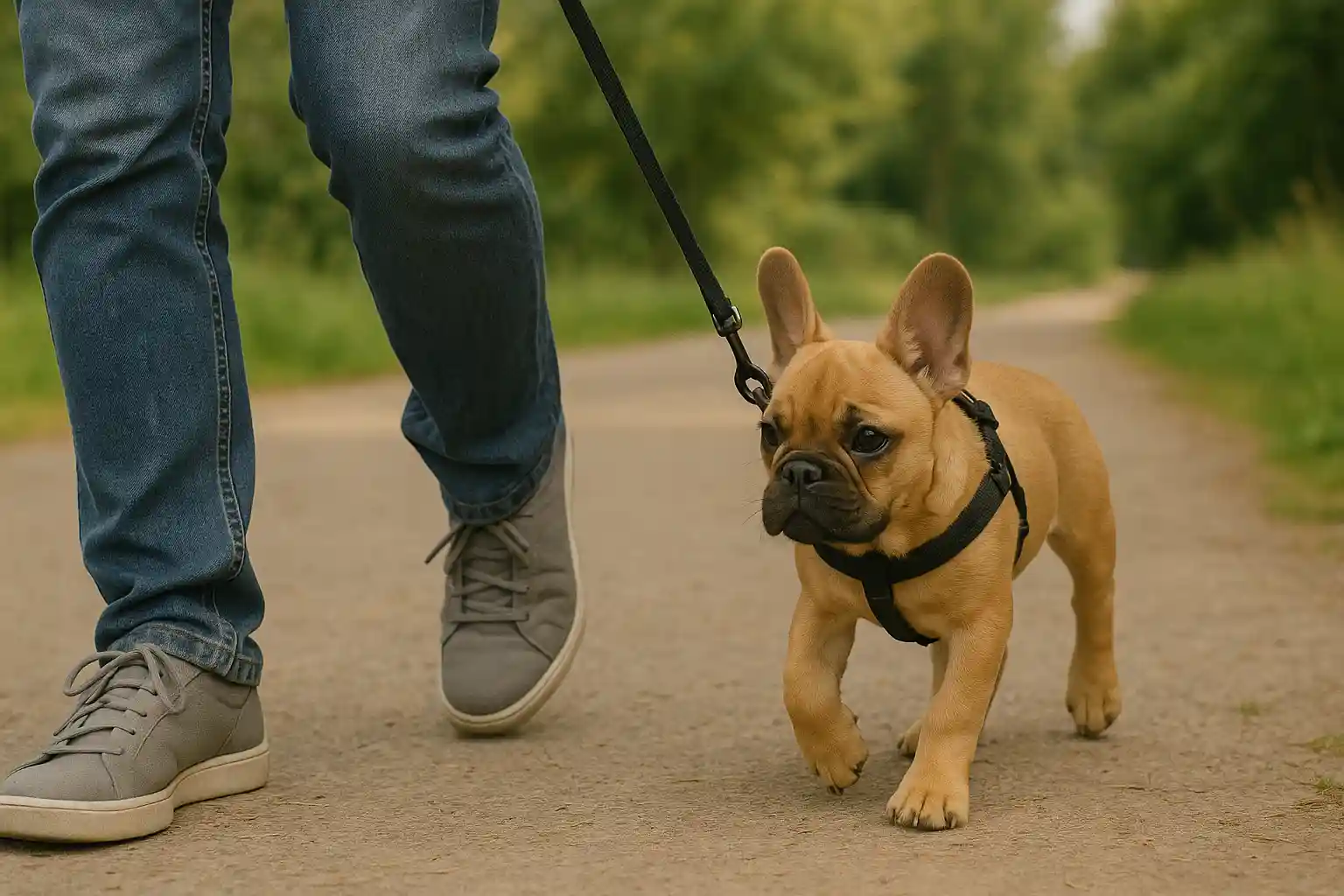
Socialization Tips for French Bulldog Puppies
Proper socialization is critical for developing a well-adjusted French Bulldog who’s comfortable in various environments and with different people and animals.
Importance of Early Socialization for French Bulldogs
When learning how to train a French Bulldog puppy, socialization should be a top priority. The socialization window for puppies is relatively short – primarily between 3-14 weeks of age. During this time, exposure to different experiences in a positive, controlled way shapes their future responses.
When I got Luna at 8 weeks, I made a socialization checklist that included exposure to:
- Different surfaces (grass, concrete, carpet, wood floors)
- Various sounds (vacuum, doorbell, traffic noise)
- Different types of people (men, women, children, people with hats/beards)
- Car rides
- Gentle handling of paws, ears, and mouth
- New environments (pet store, friend’s house, outdoor café)
I made the mistake with my first Frenchie of not exposing him to enough handling of his paws and ears. This made nail trims and ear cleaning a struggle throughout his life. With my later Frenchies, I made sure to touch these sensitive areas daily, pairing the handling with treats.
Best Practices for Introducing Your French Bulldog Puppy to Other Dogs
French Bulldogs can sometimes be overly confident despite their small size, which requires specific knowledge of how to train a French Bulldog puppy for appropriate dog interactions. This confidence can lead to challenging situations with larger dogs, so controlled introductions are essential.
When learning how to train a French Bulldog puppy to interact with other dogs, follow these steps for successful introductions:
- Start with calm, well-socialized adult dogs
- Choose neutral territory for introductions
- Keep initial meetings brief and positive
- Watch body language closely – stiff posture and raised hackles signal discomfort
- Allow parallel walking before direct interaction
- Never force interaction if either dog seems uncomfortable
When Bella met my friend’s Golden Retriever, I was nervous about the size difference. By walking them side by side before allowing sniffing, they established comfortable communication that developed into a great friendship.
Socializing Your French Bulldog Puppy with People
Because of their affectionate nature, most French Bulldogs love people. However, when learning how to train a French Bulldog puppy, proper socialization ensures they’re comfortable with all types of human interaction.
For effective socialization with people:
- Invite friends and family over regularly
- Ask visitors to offer treats (with your guidance)
- Ensure all interactions are positive and not overwhelming
- Practice gentle handling by different people
- Expose your puppy to people of different ages, appearances, and voices
I found that carrying high-value treats to give to strangers to feed my Frenchie puppies created positive associations with new people. Hugo was initially wary of men with deep voices, but after consistent positive encounters, his tail would wag whenever he met someone new.
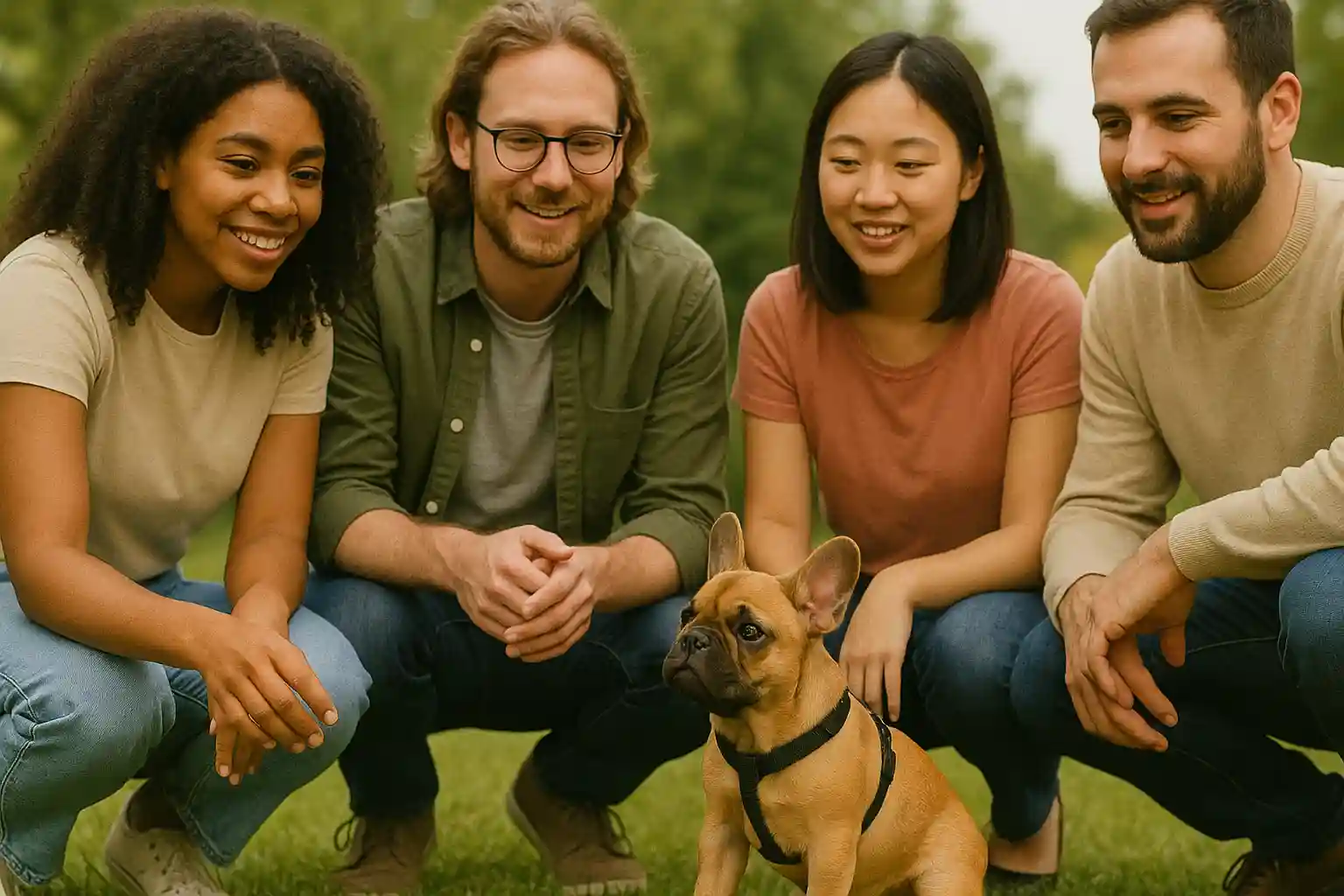
House Training Your French Bulldog Puppy
House training can be particularly challenging with French Bulldogs. Their stubborn streak sometimes means they understand what you want but choose not to comply. Consistency and routine are your best allies.
Schedule for House Training Your French Bulldog
A consistent schedule is crucial when learning how to potty train a French Bulldog puppy to eliminate outside. When house training Milo, I quickly realized that a strict schedule was essential for success.
Effective house training schedule:
- First thing in the morning
- After meals (15-30 minutes after eating)
- After naps
- After play sessions
- Before bedtime
- Every 2 hours during the day initially
This might seem excessive, but Frenchies have small bladders, and prevention is easier than correction. I set alarms on my phone for the first few weeks to maintain consistency.
For nighttime, removing water about 2 hours before bedtime helped reduce overnight accidents. However, puppies under 4 months will likely still need a middle-of-the-night bathroom break.
Recognizing Signs That Your French Bulldog Needs to Go Outside
Learning your Frenchie’s pre-elimination signals is a crucial part of how to train a French Bulldog puppy for successful house training. Recognizing these signs saves a lot of cleanup. Common signs include:
- Circling or pacing
- Sniffing the floor intently
- Whining or going to the door
- Returning to a previously used accident spot
- Suddenly stopping play
- Restlessness
With Luna, her tell was subtle – she would suddenly stop whatever she was doing and walk with purpose. I had to watch her closely to catch this signal, but once I did, accidents reduced dramatically.
When you see these signs, immediately take your puppy outside to their designated bathroom spot. Use your chosen cue word (“potty,” “business,” etc.) and reward generously when they eliminate outdoors.
Solutions for Common House Training Challenges
French Bulldogs can present unique house training challenges. Here’s how I addressed the most common issues when learning how to potty train a french bulldog puppy for reliable house manners:
Challenge: Eliminating in the same indoor spot repeatedly Solution: Clean thoroughly with an enzymatic cleaner to completely remove the scent. Temporarily block access to the area or place their food bowl there (dogs rarely eliminate where they eat).
Challenge: Refusing to eliminate outside during bad weather Solution: French Bulldogs are notorious for their dislike of rain and cold. I trained Bella to use a covered area of the yard, and for particularly bad weather, we used a grass pad on a covered porch.
Challenge: Stealth accidents Solution: Keep your puppy in the same room with you, possibly tethered to you with a leash, until they’re more reliable. This prevents them from sneaking off to have accidents.
Challenge: Submissive urination when excited Solution: Keep greetings low-key. Avoid looming over your puppy or using an excited voice until they’ve matured and gained bladder control.
The most important house training advice I can offer is patience. My Frenchies took longer to house train than other breeds I’ve had, but with consistency, they all eventually mastered it.
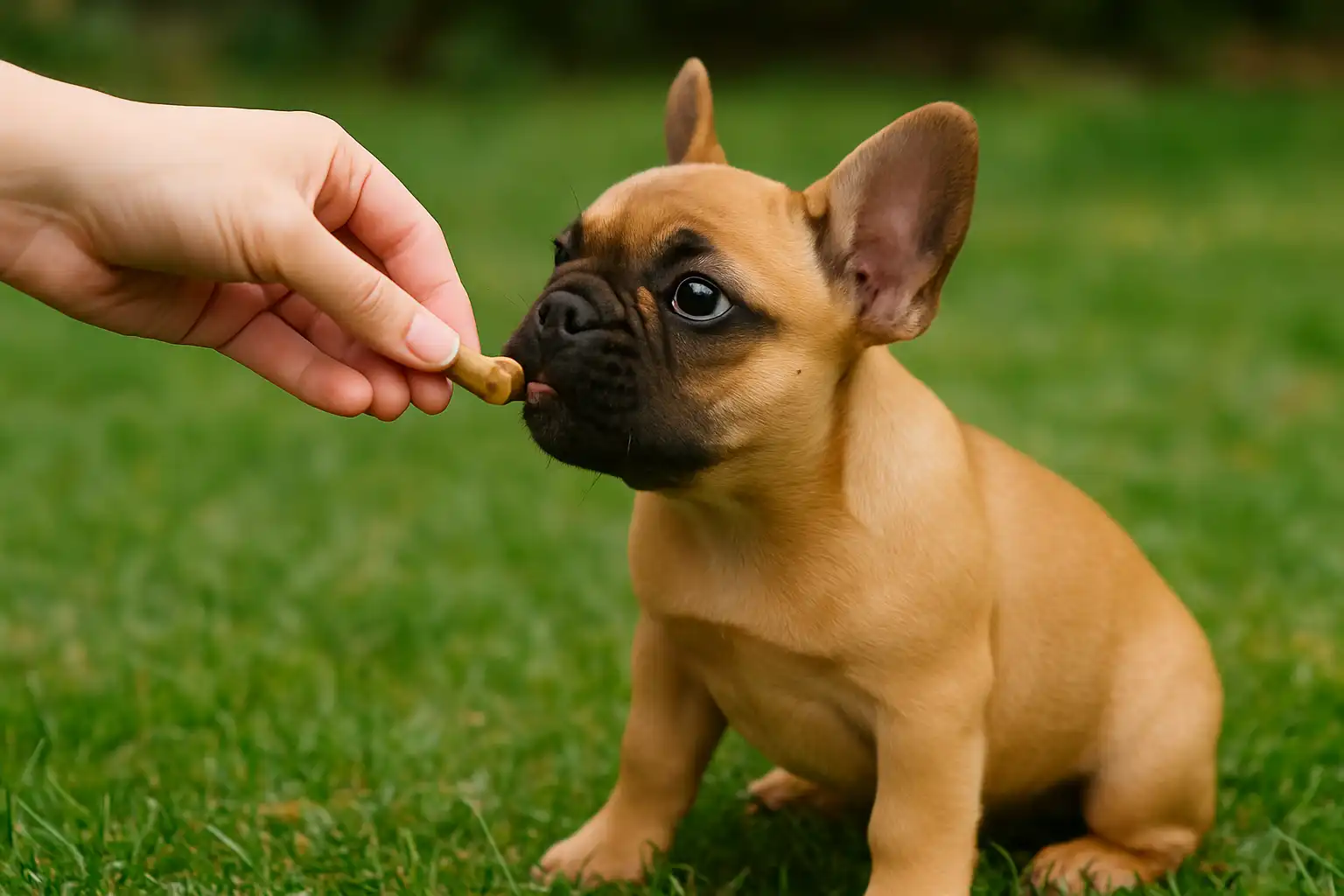
Behavioral Issues and Training Solutions
Every French Bulldog puppy has their quirks, but some behavioral challenges are common to the breed. Knowing how to train a French Bulldog puppy with behavior issues is crucial. Addressing these early prevents them from becoming ingrained habits that are harder to correct later.
Addressing Bite Inhibition in French Bulldog Puppies
Frenchie puppies explore the world with their mouths, but teaching bite inhibition is essential for a well-mannered adult dog.
When Milo was a puppy, his sharp teeth were like needles. I found these techniques effective:
- Whenever he bit too hard, I would make a high-pitched “ouch” sound and stop playing immediately
- If he continued, I would leave the room briefly (10-15 seconds)
- Consistent redirection to appropriate toys
- Planned puppy playdates with well-socialized dogs who would teach bite inhibition naturally
The key was consistency – everyone in the household had to respond the same way to nipping. Within a few weeks, Milo learned to control his bite pressure, and by 5 months, play-biting had mostly stopped.
Solutions for Excessive Barking in French Bulldogs
While French Bulldogs aren’t known for being excessive barkers compared to some breeds, knowing how to train a French Bulldog puppy not to bark unnecessarily is an important skill. They can develop the habit without proper training.
When Hugo started alert barking at every sound outside, I implemented this training plan:
- Identify the barking trigger (in his case, delivery trucks)
- Create a “thank you” command – acknowledging his alert but signaling it’s time to stop
- Reward quiet behavior after the “thank you” command
- For persistent barking, redirect to a previously trained command like “sit” or “place”
- Ensure adequate exercise and mental stimulation to reduce boredom barking
Never yell at your Frenchie for barking, as they may interpret your raised voice as joining in. Instead, stay calm and consistent with the desired alternative behavior.
Managing Separation Anxiety in French Bulldog Puppies
French Bulldogs form strong bonds with their people, making them susceptible to separation anxiety. When learning how to train a French Bulldog puppy, preventing separation anxiety is much easier than treating it once established.
To prevent separation anxiety:
- Practice brief departures and returns without making a fuss
- Create positive associations with your leaving cues (picking up keys, putting on shoes)
- Leave high-value toys that are only available when you’re gone
- Start with short absences and gradually increase duration
- Consider calming music or white noise when you’re away
- Ensure they’ve had exercise before being left alone
When I first left Luna alone, she howled so loudly my neighbor texted me. I had to start training from scratch, leaving for just 30 seconds at a time. After several weeks of gradual training, she could comfortably stay alone for a few hours.
For severe cases, consult with a veterinarian about potential anxiety supplements or medications while working on behavioral training.
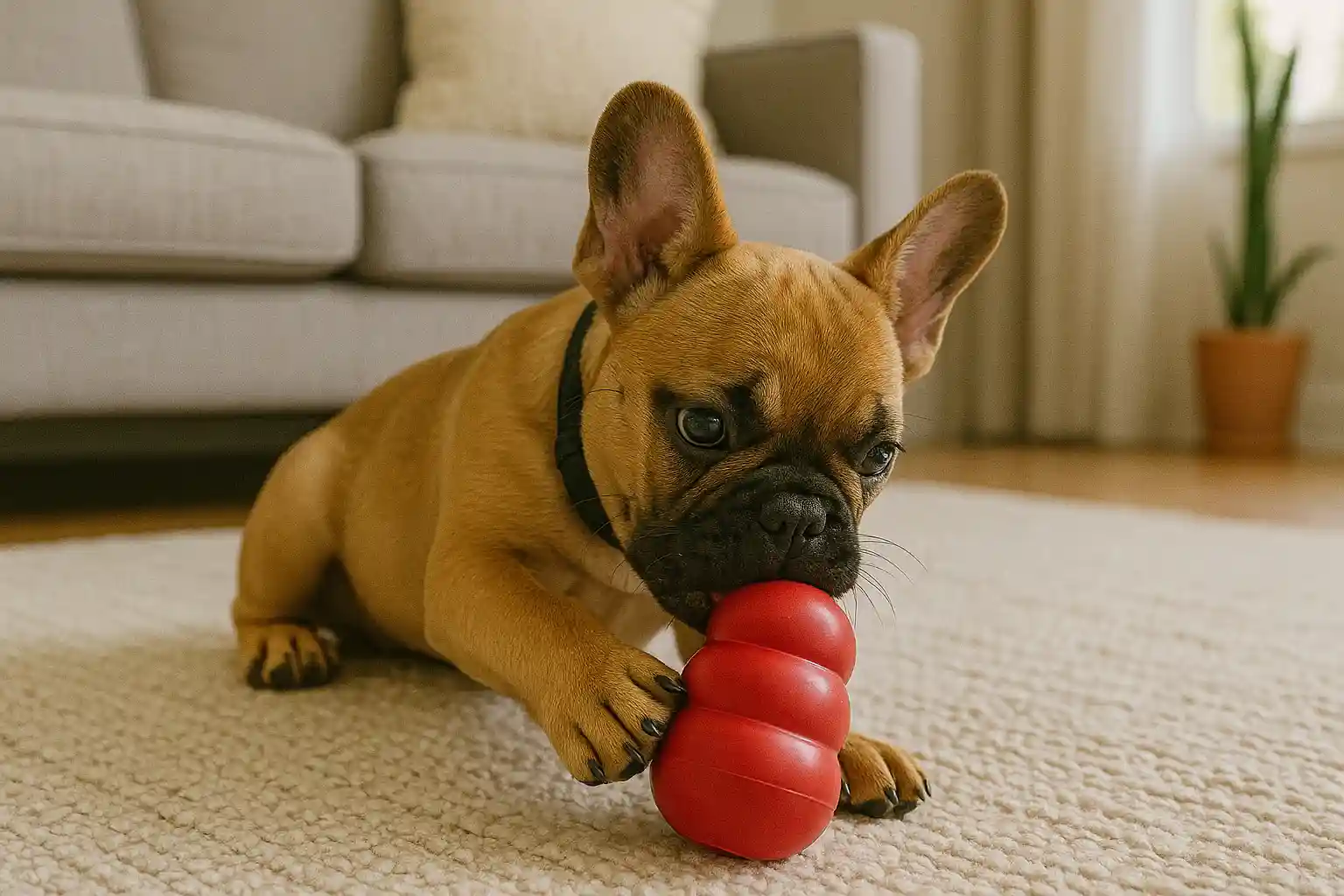
Health and Safety Considerations During Training
When learning how to train a French Bulldog puppy, you must consider their specific health needs. French Bulldogs have unique health considerations that should inform your training approach. Their brachycephalic (flat-faced) anatomy requires special attention throughout the training process.
Understanding Health Risks During Training for French Bulldogs
My first wake-up call when learning how to train a French Bulldog puppy came during an enthusiastic training session with Milo on a warm day. His breathing became labored, and he overheated quickly – a scary reminder of the breed’s respiratory challenges.
Important health considerations:
- Keep training sessions short (5-10 minutes) to prevent overexertion
- Train in climate-controlled environments – avoid hot or humid conditions
- Be mindful of respiratory sounds (excessive panting, wheezing, snorting)
- Schedule training away from mealtimes to reduce risk of bloat
- Use harnesses instead of collars to protect their airways
- Be aware of potential joint issues – avoid jumping from heights
French Bulldogs are prone to spinal issues, so I never trained behaviors that required jumping onto or off furniture until my dogs were fully grown, and even then, I provided ramps for higher surfaces.
Safe Training Environment for Your French Bulldog Puppy
Creating a safe training space is essential when learning how to train a French Bulldog puppy. A proper environment prevents accidents and keeps training sessions productive.
For a Frenchie-safe training environment:
- Control temperature – cool environment is better than warm
- Provide non-slip flooring for secure footing
- Remove hazards like electrical cords or small objects that could be swallowed
- Secure any toxic plants or substances
- Have fresh water always available
- Create a quiet space free from excessive distractions initially
When training Luna, I discovered she was slipping on our hardwood floors during excitement, so I added yoga mats for training sessions to prevent injury.
Recognizing Overexertion and Rest Needs in French Bulldog Puppies
Frenchies often don’t know when to stop and will push through discomfort to please you. Learning to recognize when your puppy needs a break is an essential part of how to train a French Bulldog puppy safely.
Signs of overexertion:
- Excessive panting
- Tongue extending far out and turning darker pink/purple
- Drooling more than usual
- Slowing down or reluctance to continue
- Seeking shade or cool surfaces
- Glazed expression
With Hugo, I learned to watch his breathing pattern closely. When his panting became uneven or louder than normal, it was time to end the training session, regardless of how briefly we’d been working.
Enforced rest periods are as important as training sessions for French Bulldog puppies. Their growing bodies need ample recovery time, and they often won’t choose to rest on their own.
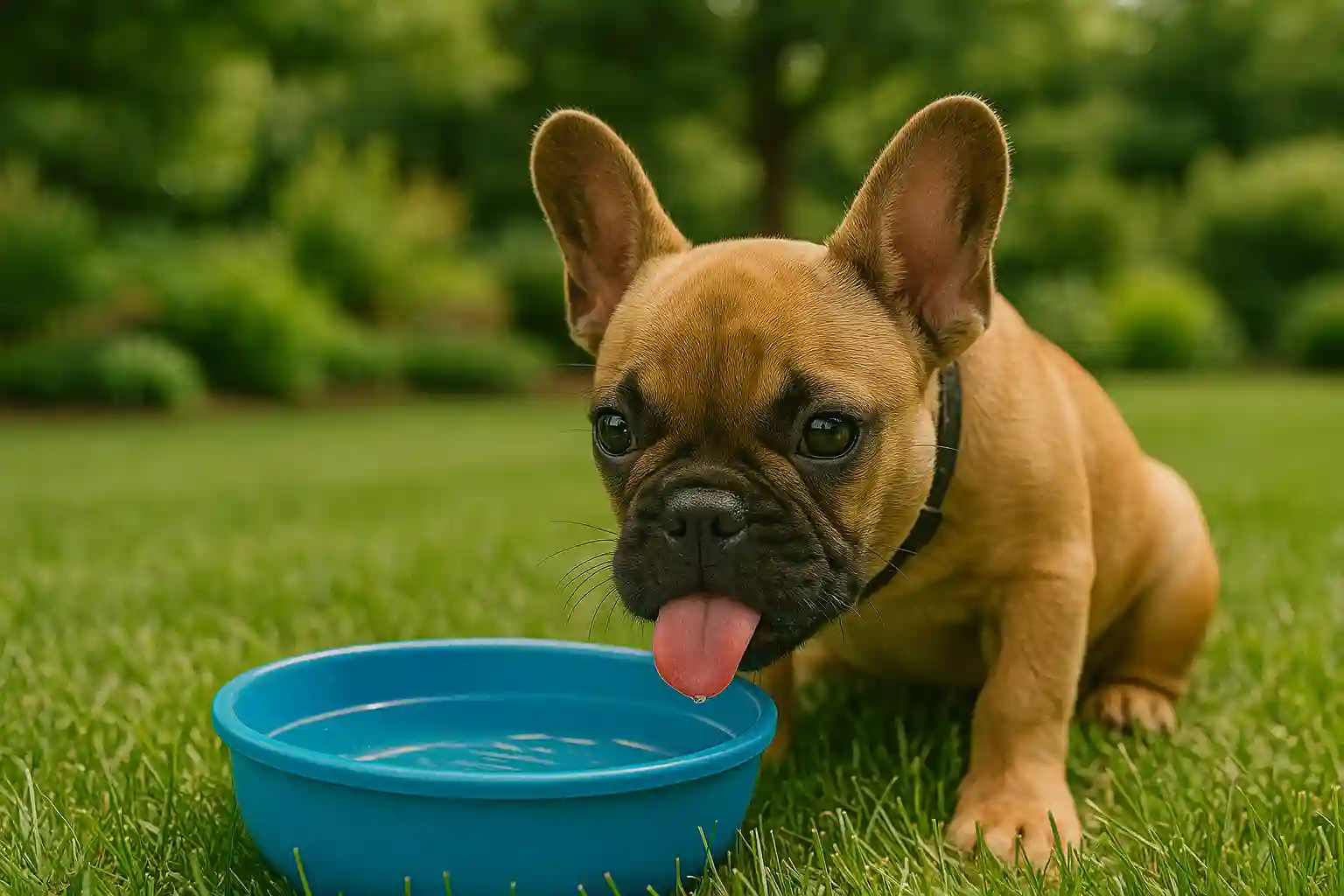
Conclusion
Learning how to train a French Bulldog puppy is a journey that requires patience, consistency, and understanding of their unique breed characteristics. From my years with these adorable companions, I’ve learned that while they can certainly be stubborn, their desire to please and their natural intelligence make training possible and rewarding. The methods I’ve outlined for how to train a French Bulldog puppy have been tested and refined through real experience.
Remember that every Frenchie has their own personality – what works for one may need adjustment for another. My three Frenchies each responded differently to training techniques, reminding me that learning how to train a French Bulldog puppy requires flexibility and observation.
The bond you build during training will form the foundation of your relationship for years to come. When frustration sets in (and it will), remember that your Frenchie puppy isn’t giving you a hard time – they’re having a hard time. Respond with patience, and your efforts in learning how to train a French Bulldog puppy will be rewarded with a well-mannered, happy companion.
For more specific training challenges, explore our guides on Is a French Bulldog Easy to Train and How to Potty Train a French Bulldog puppy. For a more comprehensive approach, visit our complete French Bulldog training guide.
Frequently Asked Questions
Are French Bulldog puppies easy to train?
French Bulldog puppies are moderately easy to train compared to other breeds. They’re intelligent and eager to please, but their stubborn streak can make training challenging. Success depends on using positive reinforcement, keeping sessions short (5-10 minutes), maintaining consistency, and starting training early when they’re most receptive to learning.
How do you discipline a French Bulldog puppy?
Discipline a French Bulldog puppy through positive reinforcement rather than punishment. Redirect unwanted behaviors to appropriate alternatives, use a firm (not angry) “no” followed by showing the correct behavior, and reward good behavior generously. French Bulldogs respond poorly to harsh methods, which can damage trust and cause anxiety or aggression.
Can I leave my French Bulldog home alone for 8 hours?
Adult French Bulldogs should not be left alone for 8 hours regularly due to their social nature and potential for separation anxiety. Puppies under 6 months shouldn’t be alone for more than 3-4 hours maximum. If you work full-time, arrange a mid-day visit from a dog walker, use doggy daycare, or consider a pet sitter to prevent behavioral issues.
How to train a French Bulldog not to pee in the house?
Train a French Bulldog not to pee in the house by establishing a strict schedule (taking them out every 2-3 hours), using a crate when unsupervised, immediately taking them outside after meals/naps/play, rewarding outdoor elimination with treats and praise, thoroughly cleaning accidents with enzymatic cleaners, and maintaining consistency until reliable habits form.
Do French Bulldogs sleep a lot?
Yes, French Bulldogs do sleep a lot—and it’s totally normal!
On average:
Puppies can sleep 18–20 hours a day, just like human babies. They need lots of rest to grow and recharge.
Adult Frenchies usually sleep around 12–14 hours per day.
Senior Frenchies may nap even more due to lower energy levels.

